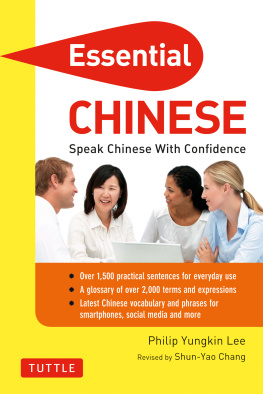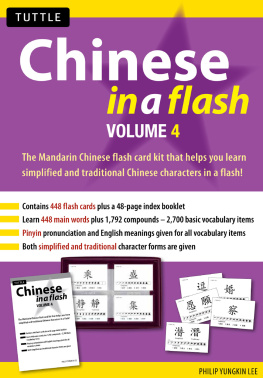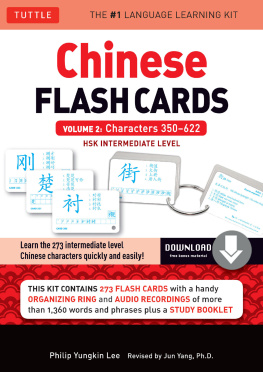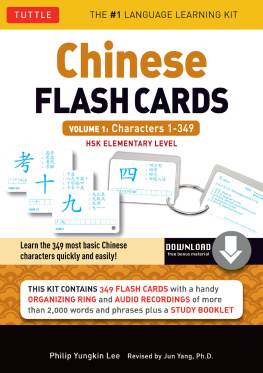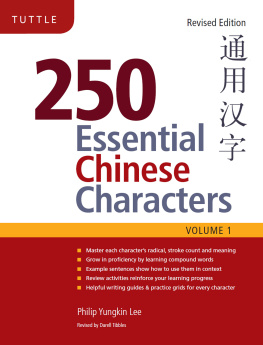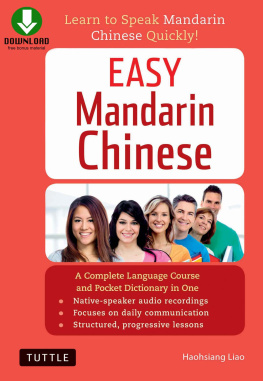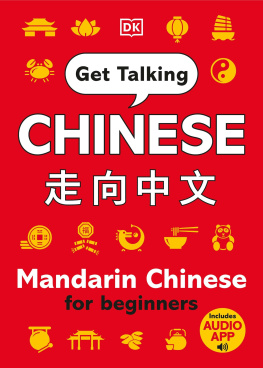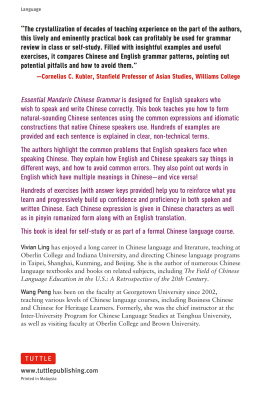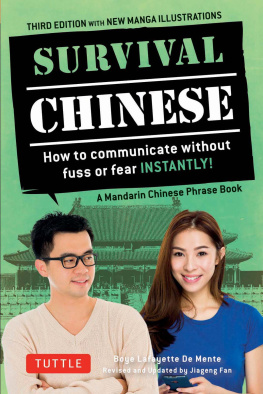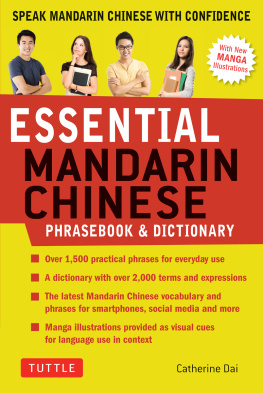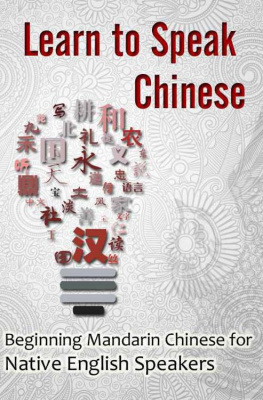
Basic grammar Compared to many European languages, Chinese grammar is quite simple. There are no verb conjugations, no plurals, no gender in nouns, no articles and the sentence order is intuitive to English speakers. This section presents Chinese grammar in parts of speech familiar to English speakers. 1 Word order More often than not, Chinese word order is the same as in English:
| subject verb object |
| W xu Hny | I study Chinese |
2 Nouns and pronouns Mandarin words are mostly made up of two characters and nouns are no different. No distinction is made between singular and plural nouns. When it is necessary to distinguish plurals, this is done through the use of measure words which indicate the number of items involved.
For example, the word for hotel, bn'gun can be either singular or plural unless it is necessary to indicate that there are more than one. Thus,
| y ji bngun | one hotel |
| ling ji bngun | two hotels |
| sn ji bngun | three hotels |
In the above examples, the noun bn'gun hotel is qualified by a number with the appropriate measure word ji , which indicates whether or not it is singular or plural. You will notice that whereas the number r two is used in counting, e.g., y , r , sn ... one, two, three ... the word ling a couple of replaces r two where a measure word is used. Like nouns, Chinese pronouns do not change form whether they are used as subjects or objects.
Simple personal pronouns are: w I/me, n you, t he/him, t she/her and t it (the last three pronouns share the same pronunciation but are written with different characters). Unlike nouns, however, Chinese pronouns can take on plural forms with the addition of the suffix -men , making the above examples into wmen we/us, nmen you (plural), tmen they/them (either all male or mixed) and tmen they/them (all female). Similarly, the pronoun for animals or insects is tmen they/them. The suffix -men is added to nouns only sparingly in greetings, e.g., nshmen , xinshengmen ladies and gentlemen, as it is unnecessary to indicate plural forms in nouns. In addition to personal pronouns, there are demonstrative pronouns. For example, zh this and n that.
It is important to note that a plural measure word xi is added to give the plural forms of these pronouns: zhxi these and nxi those, so it is not a plural form in the sense that -men is used. 3 Possessives and measure words To make a possessive out of a noun or pronoun, simply add the particle de . Thus,
| doyu de | the tour guides |
| L xiojie de | Miss Lis |
| wde | my or mine |
| nde | your (singular) or yours |
| tde | / | his/her |
| wmende | our |
| nmende | your (plural) or yours (plural) |
| tmende | their or theirs |
You have learned to use measure words in conjunction with numbers to indicate the plural form of a noun. In English we say a slice/loaf of bread, a piece/ream of paper, a school of fish etc. In Chinese this usage applies to all nouns in order to specify number, e.g., a book is ybn sh , a table is y zhng zhuzi and two chairs is ling b yzi . As you can see from the above examples, there isnt one unique measure word for each noun; measure words tend to describe classes of objects with similar characteristics.
Thus the word bn describes bound books, zhng describes wide, flat objects of many types such as tables, paper, bedsheets, etc., and b describes things with handles including chairs, knives, forks, etc. Luckily for beginners of the language, there is a general-use measure word ge which is used in simple phrases like zh ge this one, n ge that one, n ge which one or j ge how many (items)? 4 Verbs Chinese verbs are not conjugated, but keep one simple form regardless of the subject or tense. Thus the verb ch eat is the same whether the subject is I, you, he/she or they, and whether the action took place yesterday or will happen two days from now. There are ways to indicate tense in Chinese sentences, e.g., the use of time words before the verb, the use of the particles guo and le to indicate past and completed action, and the use of yo and hu to indicate future action. For example, The use of time words before the verb:
| W zutin ch jiozi. | Today I eat dumplings |
| W mngtin ch jiozi. | Tomorrow Ill be eating dumplings |
Note that the Chinese verb ch eat does not change to indicate tense; this is done through the use of zutin yesterday, jntin today and mngtin tomorrow.
Tomorrow Ill be eating dumplings | Note that the Chinese verb ch eat does not change to indicate tense; this is done through the use of zutin yesterday, jntin today and mngtin tomorrow.
The use of the particle guo after the verb to indicate action occurred in unspecified time in the past:
| W chguo jiozi. | Ive eaten dumplings previously |
The use of the particle le after the verb to indicate action has just been recently completed:
| W chle jiozi. | Ive just eaten (the) dumplings |
The use of the aspect partices yo want or hu will/shall before the verb to indicate future action:
| W yo ch jiozi. | Im going to eat (the) dumplings |
| W hu ch (nxi) jiozi. | () | Ill be eating (the) dumplings |
5 Adjectives Adjectives in Chinese are simple as they dont need to agree in gender or number with the nouns they modify. They are sometimes called stative verbs as they incorporate the verb to be in the sentence.
In their positive form, adjectives are generally preceded by the adverb hn very. Thus W hn goxng means Im very happy. When adjectives modify nouns in phrases they generally precede the noun, often using the particle de in between. For example,
| xio xingmo | a small panda |
| zng yfu | soiled clothings |
| ho pngyou | good friends |
| mil de fngjng | beautiful scenery |
| mnggu de lw | expensive gift |
| toyn de wnzi | annoying mosquitoes |
6 Adverbs Just as adjectives precede the nouns they modify, adverbs are placed before verbs, adjectives or other adverbs to express time, degree, scope, repetition, possibility, negotiation and tone of speech. Common examples are: hn very, y also, bjio rather, ji then, zng always.
The Great Wall is long. | | W y xing chngchang Bijng koy. | Id also like to try Beijing Duck. |
| Shnghi xitin bjio r. | Shanghai is rather hot in summer. |
| N xin zu, w mshng ji li. | , | You go first, Ill catch up with you later. |
| Wyu de shhou, | , | Around May, it is |
| zhl zng xiy. | always raining here. |
7 Negatives There are generally two particles that are used for forming the negative in Chinese.
always raining here. | 7 Negatives There are generally two particles that are used for forming the negative in Chinese.
They are b/b and mi . The one youre most likely to need is b , sometimes pronounced as b when it precedes a word in the fourth tone. Both b and b are placed before verbs or adjectives to indicate negation in simple present tense. To indicate negation in the past tense, i.e., an action that has not been completed, mi is used.
| Gungzhu dngtin b lng. | It does not snow in Shanghai in winter. |
| Qnin Bijng mi xixu. | Last year it didnt snow in Beijing. |
Next page
